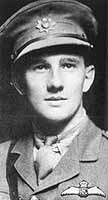Related Research Articles

LeutnantKarl Allmenröder was a German World War I flying ace credited with 30 aerial victories. The medical student son of a preacher father was seasoned in the trenches as an 18-year-old artilleryman in the early days of the First World War, earning promotion via battlefield commission to Leutnant on 30 March 1915. After transferring to aviation and serving some time as an artillery spotter in two-seater reconnaissance airplanes, he transferred to flying fighter aircraft with Jagdstaffel 11 in November 1916. As Manfred von Richthofen's protege, Karl Allmenröder scored the first of his 30 confirmed victories on 16 February 1917. Flying a scarlet Albatros D.III trimmed out with white nose and elevators, Allmenröder would score a constant string of aerial victories until 26 June 1917, the day before his death. On 27 June 1917, Karl Allmenröder fell to his death near Zillebeke, Belgium. His posthumous legacy of patriotic courage would later be abused as propaganda by the Nazis.
John Inglis Gilmour, was a British flying ace of the First World War. He was the highest scoring Scotsman in the Royal Flying Corps, with 39 victories.
Flight Lieutenant James Anderson Slater was a British First World War flying ace, credited with 24 aerial victories. He served in the Royal Air Force (RAF) as an instructor after the war until killed in a flying accident.
Captain Thomas Frederic Williams MC was a Canadian First World War flying ace, officially credited with 14 victories.
Captain William Otway Boger was a Canadian World War I flying ace credited with five aerial victories.
Joseph Cruess Callaghan, was an Irish flying ace of the First World War, credited with five aerial victories.
Captain Sydney Philip Smith, was a British First World War flying ace, who was credited with five aerial victories, before being shot down and killed, the 76th victory of Manfred von Richthofen.
Rothesay Nicholas Montagu Stuart Wortley, was a British World War I soldier, Royal Flying Corps fighter pilot and a journalist and author.
Captain Guy Borthwick Moore (1895–1918) was a Canadian World War I flying ace credited with ten aerial victories.
Alfred Seymour Shepherd, was an Australian fighter ace of the First World War. He was credited with ten aerial victories. A civil engineer by profession, he enlisted in the Australian Imperial Force in 1915, and served with infantry battalions in France. He transferred to the Royal Flying Corps in 1916 and was posted to No. 29 Squadron, operating Nieuport fighters. After barely two months at the front, during which his victories earned him the Military Cross and the Distinguished Service Order, he was shot down and killed by a German ace in July 1917. He was buried in France.
Lieutenant Colonel Spencer Bertram Horn was a British soldier and World War I flying ace credited with thirteen aerial victories. Although seconded to aviation duty during the First World War, he returned to his Dragoon Guards regiment after the war ended. Horn then served in India in the 1920s and 1930s, while his cavalry unit modernised to tanks. Horn would serve in India during the Second World War, and retire from active duty on 3 October 1946, and from the reserves on 15 November 1950.

Flight Lieutenant Robert Leslie Chidlaw-Roberts was a British World War I flying ace credited with ten aerial victories. During his aerial combat career, and in different dogfights, he engaged two famous German aces; he was one of the British pilots who downed Werner Voss, and on 9 January 1918, he shot down and killed Max Ritter von Müller.
Wing Commander Selden Herbert Long, was an English flying ace during the First World War. He was credited with nine confirmed aerial victories. He was also noted for the audacity of his trench strafing missions–an early form of close air support.
Captain Edwin Louis Benbow was an English flying ace during the First World War, credited with eight victories, comprising six destroyed and one shared destroyed, and one 'out of control'. He was the only pilot to gain 'ace' status flying the Royal Aircraft Factory F.E.8 exclusively.

Captain Clive Franklyn Collett was a World War I flying ace from New Zealand credited with 11 aerial victories. He was the first British or Commonwealth military pilot to use a parachute, in a test. While serving as a test pilot, he crashed to his death in a captured German fighter.
Captain Bernard Paul Gascoigne Beanlands was a Canadian World War I flying ace credited with eight aerial victories.
Captain Charles George Douglas Napier, was a British World War I flying ace credited with nine aerial victories before being killed in action.
Austin Lloyd Fleming, MC was a Canadian flying ace of the First World War. He was credited with eight aerial victories.
Captain Conway MacAllister Gray Farrell was a Canadian flying ace during World War I. He was credited with seven aerial victories.
Captain Jeffery Batters Home-Hay was a Scottish-born Canadian who became a flying ace during World War I. He was a bomber pilot when he was credited with seven aerial victories. He was shot down and captured toward the end of World War I. After being repatriated, he became a pioneering Canadian bush pilot. By the end of his aviation career, he was the oldest pilot still flying in Canada.
References
- ↑ "Harry Alison Wood". www.theaerodrome.com. Retrieved 8 October 2016.
- ↑ Above the Trenches Supplement. pp. 5–6.
- Christopher F. Shores; Norman L. R. Franks; Russell Guest (1996). Above the Trenches: Supplement. Grub Street. ISBN 978-1-898697-39-8.